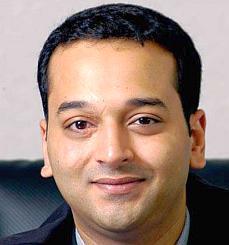 | « Back to article | Print this article |
Mumbai-based property developer HDIL's stock, once the darling of investors, came crashing down last month. It lost nearly 40 per cent of its value from Rs 120.85 on January 21 to Rs 74.65 on January 24 as investors worried about the ability of the company to sort out its finances.
It lost nearly 40 per cent of its value from Rs 120.85 on January 21 to Rs 74.65 on January 24 as investors worried about the ability of the company to sort out its finances.
The fall had the company’s vice-chairman and managing director, Sarang Wadhawan, burning up the phone lines as he tried to calm anxious investors by addressing their concerns. But the damage was done.
The immediate trigger for the fall was Wadhawan's decision to sell 1 per cent, or 5 million shares, of HDIL to raise Rs 57 crore (Rs 570 million) in order to meet the payment obligations for land bought in south Mumbai in 2010.
While on the face of it, it may seem like an innocuous move, there were plenty of other factors at work here.
Collateral damage
For one, why did the promoter have to sell shares for a paltry Rs 57 crore? Was the company facing a financial crunch? Then there was the larger issue of promoters pledging their shares.
The promoters have pledged almost 98 per cent of their shares to banks and financial institutions as collateral in exchange of loans or working capital, raising concern about the company’s high debt.
“If 10 to 20 per cent stake is pledged, it is normal, but when 98 per cent is pledged, it becomes a problem,” says AK Prabhakar, senior vice-president (equity research) at Anand Rathi Financial Services.
Investors, therefore, went into a tizzy with the likes of Citigroup and Credit Suisse off-loading major chunks of their shares.
Macquarie Equities Research, which hosted the conference call after the crash, says: "We hosted the management call where 140 clients dialled in to seek answers. While the management has tried to give a rational explanation, our interaction with investors reveals that they need more clarity before confidence is restored.”
What went wrong? The real estate sector has been struggling with uncomfortably high debts and slowing sales for some years now.
Among large companies, the promoters of Parsvnath Developers have pledged over 93 per cent of their shares, while the promoters of Unitech have pledged 76.71 per cent as on December 2012.
HDIL, analysts say, is facing its own peculiar problems: delay in getting cash from buyers, lower launches, delays in the MIAL (Mumbai International Airport Project) project and high debt.
Payments from pre-sales are often delayed, which means the company is booking sales, but money isn't coming into its coffers.
Mostly developers pre-sell property to fund projects and, therefore, any delay in payments hurts their cash-flows and forces them to borrow more.
As a result, HDIL had Rs 868 crore (Rs 8.68 billion) debtors (mostly dues from customers) on inventories worth Rs 11,671 crore (Rs 116.71 billion).
For a company whose annual turnover was Rs 2,006 crore (Rs 20.06 billion) in FY 2012, the amount of debtors and inventories is unusually high.
It has a consolidated debt of around Rs 4,000 crore (Rs 40 billion). Its cash flows was at Rs 814 crore (Rs 8.14 billion) in FY 2012, and it spent Rs 624 crore (Rs 6.24 billion) on interest payment and Rs 953 crore (Rs 9.53 billion) towards payment of long-term debt.
Sectoral woes
Among the bigger Mumbai realty companies, with the exception of Indiabulls Real Estate, HDIL's inventories and debtors is the highest.
Indiabulls had a debt of Rs 930 crore (Rs 9.30 billion), inventories of Rs 5,110 crore (Rs 51.10 billion) and net sales of Rs 1,391 crore (Rs 13.91 billion) in FY 2012.
The country’s largest developer, DLF, had inventories worth Rs 16,175 crore (Rs 161.75 billion) and debtors of Rs 1,765 crore (Rs 17.65 billion) on total sales of Rs 9,629 crore (Rs 96.29 billion) in FY 2012.
Poor